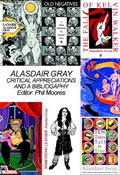Edited by Phil Moores
Introduction by Will Self
[Read Will’s introduction online]
Synopsis
From “Lanark” to “The Book of Prefaces”, Alasdair Gray, more than any other writer still working, can be claimed as the modern successor to William Blake. As well as being award-winning tales, his books are also works of art, from the embossed boards to his own illustrations: books, not texts. Since “Lanark” appeared in 1981, Gray has produced work of all kinds – novels, short stories, poetry, polemic, plays – all of which retain the sense of humour, Scottish heart, intellectual curiosity and unique style that is Gray’s mark. This volume of essays contains a detailed bibliography of Gray’s writing and design, illustrations of his artwork and original essays from such diverse hands as the poet Professor Philip Hobsbaum, Kevin Williamson, author of “Drugs” and “The Party Line”, and Jonathan Coe, author of “The Rotters’ Club”. In addition, the illustrated jacket has been designed by Alasdair Gray himself, who is also contributing a personal view of his career to date.

